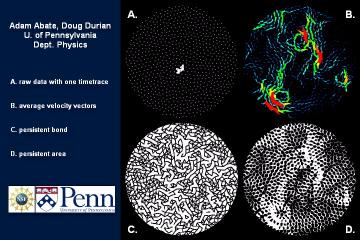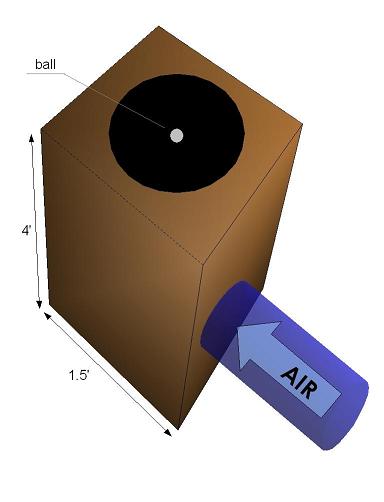

Here is a movie showing spatially heterogeneous dynamics and the persistent area and persistent bond diagrams used to quantify them. The file is 354 MB.
This is a movie of the traces of densely packed spheres being driven in the gas fluidized bed. Each sphere leaves its trace for 1 second behind it and the traces are colored according their displacement. Therefore, the fast particles are colored red and the slow are blue. There is much cooperative motion in the form of strings and swirls. One can measure a dynamical correlation length based on the size of the strings and swirls and finds that this length increases with approach to jamming.
The gas fluidized bed is an example of a driven non-equilibrium system. Ours consists of a custom built windbox with a blower connected at the bottom and a very flat mesh at the top to allow the air to flow out. Grains are placed on the mesh above and shed wakes at random due to the turbulent airflow. For a single ping-pong ball the resulting motion can be described by statistical mechanics such that the ball behaves in perfect analogy with a Brownian particle trapped in a harmonic potential [Ojha et. al, Nature, Feb. 5 2004 427(6974), 521-523].
My current experimental work has focused on understanding densely packed amorphous configurations of steel ball bearings in the gas fluidized bed. We begin with a bidisperse mixture of beads at low packing fractions and gradually add beads to approach jamming. Interestingly, the approach to jamming was found to be in many ways reminiscent of quenching molecular liquids into a glassy state. Similar to a glass there is a dramatic slowdown in dynamics with correspondingly subtle changes in structure [Abate, Durian, cond-mat/0604632 Mar. 2006]. We also found that the motion of the beads is correlated into strings and swirls which are reminiscent of dynamical heterogeneities that have been observed in simulations of supercooled liquids. We've been collaborating with Sharon Glotzer's group and the University of Michigan to better understand and quantify these heterogeneities.
We have also been developing tools to help us to better understand the system's topology -- for example, by measuring temporal fluctuations in a time varying Voronoi diagram and the evolution of the network of nearest neighbor bonds. We are able to relate temporal fluctuations in the topology to growing spatial heterogeneities on approach to jamming.
Below is a diagram of the windbox and also a selection of movies showing various systems of past study.

Movies (mpeg):
(long~8MB; short~1.6MB)
See
1 Ball!
Short version!
See
2 Balls!
Short version!
See
3 Balls!
Short version!
Let's build a ping-pong ball glass!
(files are 3 to 5 MB)
start with this...
add another ball
and another
and another
and another
and another
and another
and another
and another
and another
and another
finally...
Movies (AVI 1-2MB):
2 Nylon Balls: Picture;
Movie
10 Nylon Balls: Raw;
Eroded
3 Balls Chasing: Picture;
Movie
Liquid Steel: Picture;
Movie
Crystallized Steel:
Picture; Movie
Bidisperse Glassy Steel:
Picture;
Movie
Square: Picture;
Movie
Hex: Picture;
Movie